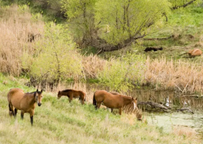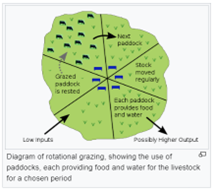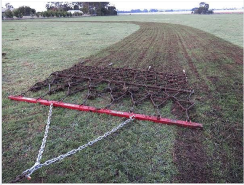As we emerge from winter, our days are get longer, air and soil temperatures slowly increase, and plants are show signs of new growth. The month of February is the perfect time to plan for the application of the compost that you have been producing and setting aside since last fall.
The following discussion on Pasture Grazing Management is a synopsis from a fact sheet prepared by the Washington State University Clark County Extension Service. Statements taken directly from the fact sheet are presented in this font while additions to this information (contributed by O2Compost) have been italicized.
Grazing season is rapidly approaching - are your pastures ready? Good pastures provide forage for your animals, absorb rainfall, filter runoff, and reduce erosion, all of which protect streams. Bare spots created by overgrazing encourage weed growth, increased erosion, runoff, and dust and may cause poor animal health.
There are five steps that you can follow to improve and better manage your pastures. These include:
- Conducting an inventory
- Creating a sacrifice area
- Implementing rotational grazing
- Mowing and harrowing
- Proper fertilizing
Pasture Inventory
 Take a walk through each pasture and conduct an inventory of the grass and weed species, fences, gates, and water troughs. Your county soil and water conservation district or extension office can provide free on-site assistance to identify weeds and best methods to control them.
Take a walk through each pasture and conduct an inventory of the grass and weed species, fences, gates, and water troughs. Your county soil and water conservation district or extension office can provide free on-site assistance to identify weeds and best methods to control them.
Locate any streams, ditches, ponds, or wetlands in your pastures. Consider fencing animals away from these areas to minimize nutrient contamination and protect habitat for fish and wildlife.
A pasture inventory should also determine soil type and fertility. You can find out the soil nutrient content by submitting a soil sample to a local laboratory.
Creating a Sacrifice Area: Rest for Tired Pastures
During the wet winter months when soils are saturated and grass growth is minimal, it is important to give your grass crop a rest. Allowing animals to graze throughout the year significantly reduces grass growth later. Soil compaction results when animals graze on saturated soils, making it difficult for grass to grow in the spring and summer.
Rotational Grazing: Graze the Best, Leave the Rest
 Grazing grass below three inches stresses the plant by reducing the leaf surface which grasses use to make their own food, thus forcing them to use up food reserves in their roots. Remember the Grazing Gold Rule: Keep grass at least three inches tall. Grass in the overgrazed areas die, thereby increasing erosion and runoff potential and leaving space for weeds to colonize.
Grazing grass below three inches stresses the plant by reducing the leaf surface which grasses use to make their own food, thus forcing them to use up food reserves in their roots. Remember the Grazing Gold Rule: Keep grass at least three inches tall. Grass in the overgrazed areas die, thereby increasing erosion and runoff potential and leaving space for weeds to colonize.
To prevent overgrazing and encourage animals to graze more evenly, try creating a rotational grazing scheme. Divide larger pastures into several, smaller pastures and then rotate your animals through these fields. Temporary fencing (often electrified) works best for this purpose.
Turn your animals out to graze a field when grass reaches six to eight inches and move them to the next pasture when the grasses reach three to four inches in height. Resting grasses allows them to regrow and collect energy to survive. When grass grows quickly in the spring, animals may be able to return to a field within two to three weeks. As grass growth slows down in the late summer and early fall, fields may need to rest for six to eight weeks.
Rotational grazing entails more effort, but it pays off in healthy animals, thriving pastures, decreased feed and vet costs, fewer weeds, less bare soil, and reduced runoff.
Mowing and Harrowing
 After moving your animals to the next pasture, it is often a good idea to mow the just grazed pasture. Mowing promotes more even grass growth of all species during the recovery period and encourages plants to produce more leaves and few stems, thus producing a more palatable, thicker, and hardy grass stand.
After moving your animals to the next pasture, it is often a good idea to mow the just grazed pasture. Mowing promotes more even grass growth of all species during the recovery period and encourages plants to produce more leaves and few stems, thus producing a more palatable, thicker, and hardy grass stand.
After moving your animals and before mowing, it is the perfect opportunity to:
- Collect the raw manure from the pasture area and add it to your compost system.
- Spread a thin layer (~1/4" or so) of compost over the entire area.
- Mow the field to break up the clumps and nestle the compost down at the root level.
Fertilizing: Right Rate, Right Time
Like any plant, grass requires nutrients to grow. It is important to avoid applying any fertilizer or compost during rainy months since the nutrients are more likely to leach into nearby water, wasting your time and money and potentially harming fish and wildlife.
Land applying compost provides many benefits to the health of your pasture, including the following:
- Nutrients in compost are stable (will not leach out) and support rapid grass growth.
- Organic matter and beneficial micro-organisms in compost drive "the soil food web".
- Composted manure is free of weed seeds, enabling the grass to out compete weeds.
- Compost decreases soil compaction, increases storm water infiltration and moisture retention, and decreases soil erosion.
- Compost reduces off-site impacts to surface and ground water resources.
Applying lime may also be appropriate and is perfectly compatible with spreading composted manure. Applying lime increases the pH of the soil, releasing more nutrients from the soil which make them more available for grass growth. Liming also enhances the effectiveness of the fertilizers and compost that you apply.
Summary
By following these recommendations, healthy plants will begin to grow earlier in the spring, become more productive throughout the growing season, and continue to grow later into the fall. To maximize pasture forage, follow the five key management principles described above throughout the year.
In short, healthy, properly managed pastures produce better quality and greater quantities of forage for your animals and lengthen the grazing season, producing healthier animals and reducing costs. Lush pastures also conserve water and filter out leachable nutrients from raw manure, keeping them from entering nearby water bodies, protecting water quality, human health, and animal health.
Read the entire Fact Sheet.